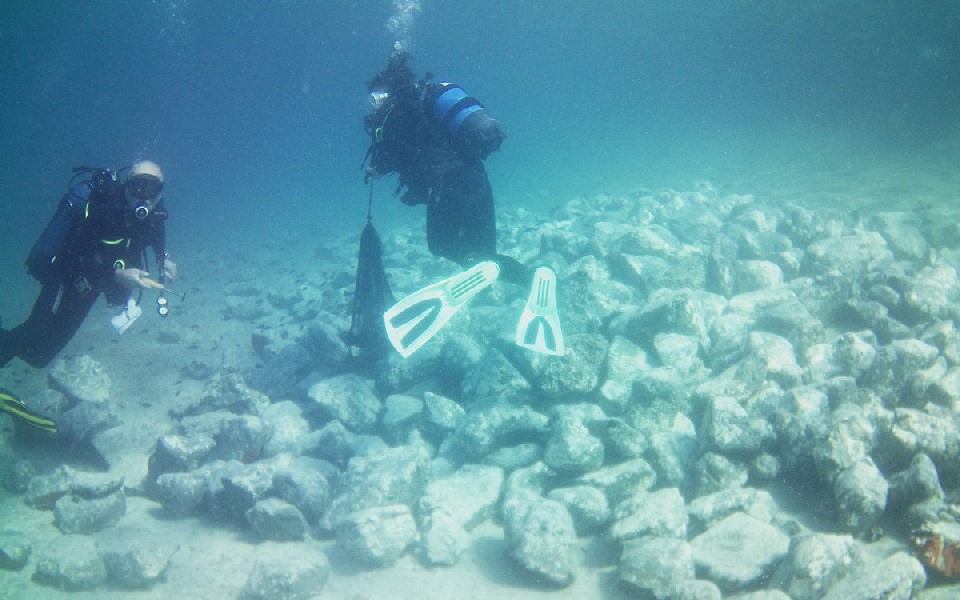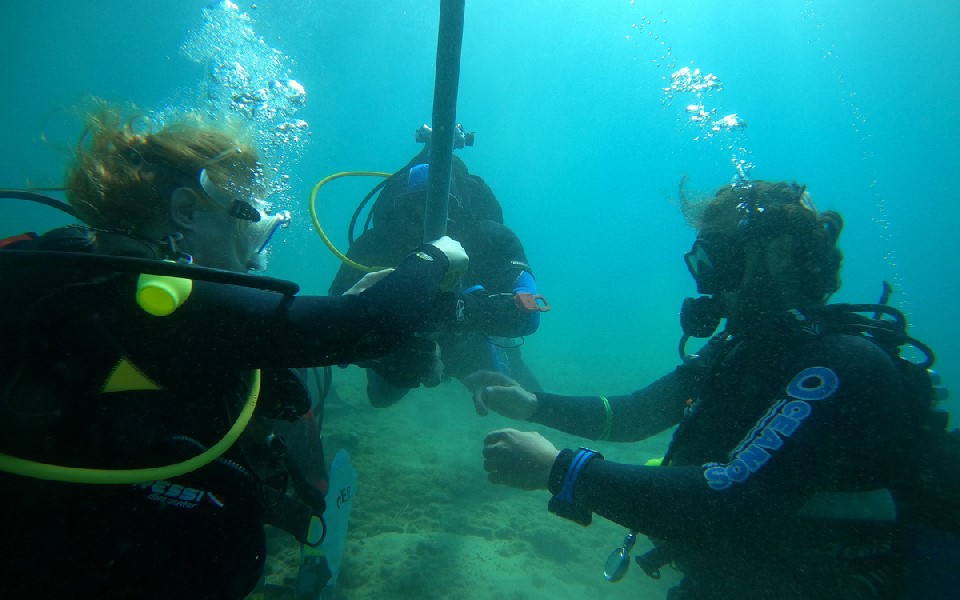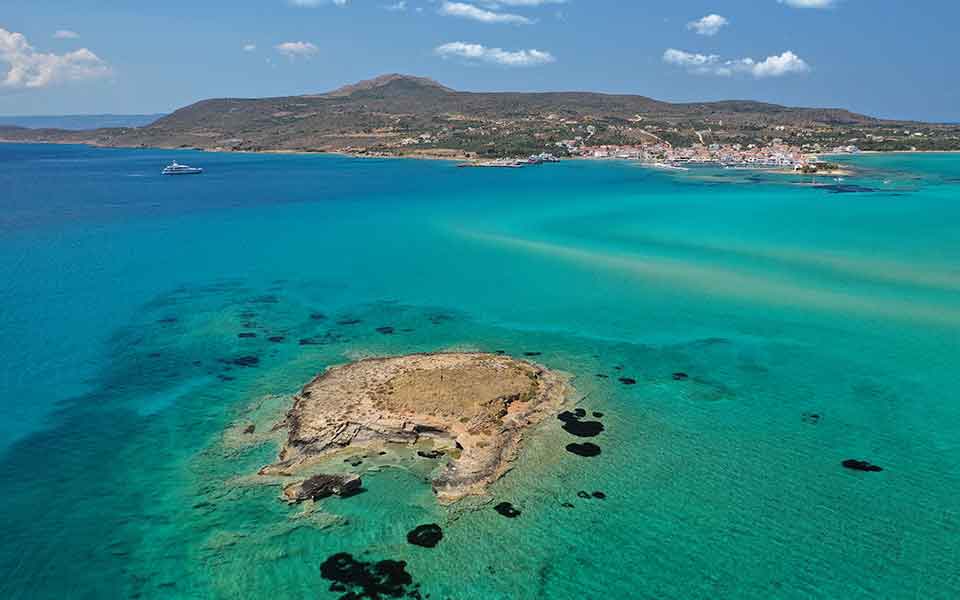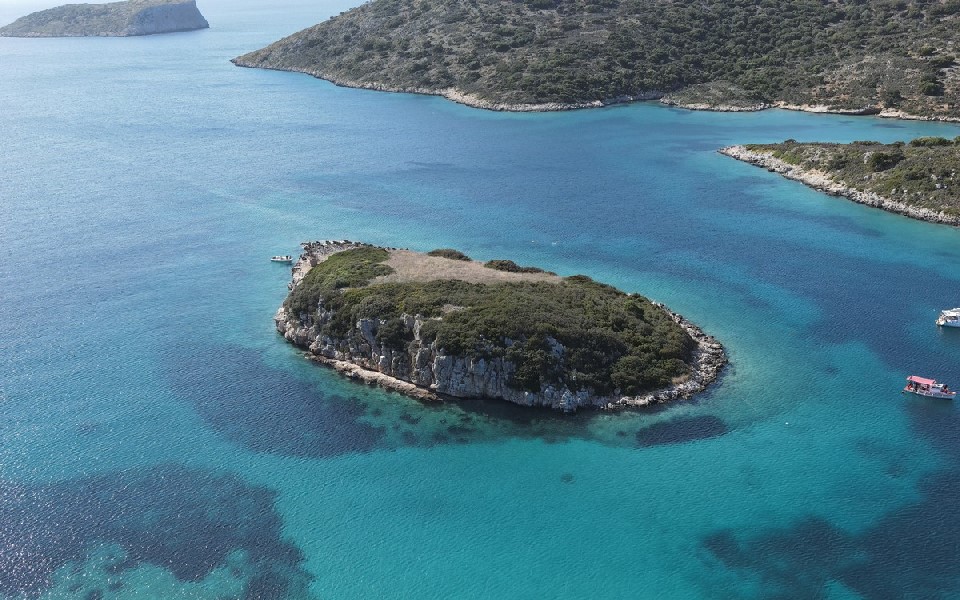Nestled in the heart of the National Marine Park of Alonnisos Northern Sporades, in a picturesque bay off the coast of Kyra Panagia island, underwater archaeologists are uncovering one of the earliest prehistoric sites on the Aegean islands. Exploration of the shallow seabed surrounding the tiny, uninhabited islet of Aghios Petros (St. Peter) have revealed the remains of a submerged Stone Age settlement, dating back roughly 8,000 years to the second half of the 7th millennium BC, offering precious insight into the lives of some of the first seafaring farmers in the Aegean.
Founded by a small yet industrious group of farmers, fishermen, and seafarers in a period known as the Early Neolithic (or “New Stone Age”), when the global sea level was 20 to 30 meters lower than at present, the settlement of Aghios Petros thrived for nearly a thousand years before it was eventually abandoned. These early settlers lived in small stone houses and left behind rich deposits of artifacts, including painted pottery, anthropomorphic figurines, and tools made from flint, as well as important clues about their diet.

© Hellenic Ministry of Culture and Sports / Ephorate of Underwater Antiquities
The island settlement of Aghios Petros site was first excavated in the early 1970s by archaeologist Dimitris Theocharis, then Commissioner of Antiquities of Thessaly. However, it wasn’t until 1981 that intensive research began, including the first underwater survey, under the direction of Professor Nikos Efstratiou of the Aristotle University of Thessaloniki, in collaboration with the renowned British oceanographer Nic Flemming, and members of Cambridge University’s Underwater Exploration Group. Describing its significance, Efstratiou noted, “the fact that the marine settlement of Aghios Petros is preserved to this day at the bottom of the Aegean, thousands of years after it was founded by the first agricultural groups that arrived in Greece, makes it a special archaeological site.”
Excavation efforts on and around the islet have unearthed a dozen stone rectangular and arched “apsidal” structures (houses), two children’s burial sites, and a range of artifacts that indicate the inhabitants of Aghios Petros, which likely numbered several family groups, were not isolated from the outside world. Thanks to varying styles of painted and incised ceramics and figurines, the settlement likely traded, directly or indirectly, with neighboring regions such as Thessaly on the Greek mainland, the southern Aegean islands, the Balkans, and Anatolia, highlighting the emerging cultural networks that crisscrossed the Aegean during the Early Neolithic.
Efstratiou emphasizes the importance of this site in the broader context of the spread of Neolithic lifeways in the region, noting, “it allows us to investigate important issues concerning the history of the island, the habitation in the Aegean, and the natural environment that the first islanders saw.”
Peeling Back the Layers
In 2021, Efstratiou and his team launched “Farmers at Sea,” a new five-year research program (2021-2025) to further explore the submerged site of Aghios Petros, with the support of the Hellenic Ministry of Culture’s Ephorate of Underwater Antiquities. Endorsing this latest round of research, Nic Fleming, who co-directed the first underwater survey in 1981, said “New work is needed with modern techniques and diving gear to find the full extent of the submerged settlement, to excavate sequential stratigraphic layers identifying the culture at different dates, and to study how the settlement became submerged in the sea.”
Working at depths of 5 to 7 meters, divers have carefully documented visible archaeological features and artifacts, including several stone walls and deposits of pottery.
Earlier terrestrial excavations on the islet revealed food remains, including various species of domestic animals (sheep, goat, pigs, cows), hunted animals (deer), fish, shellfish, and birds, further demonstrating the mixed economy that sustained the community. The combination of hunting, animal husbandry, fishing and seafaring made Aghios Petros a resilient society, capable of adapting to the unique challenges of island life. The current project also hopes to uncover further details about the nature of early seafaring in the Aegean. As Efstratiou explains, “We are also looking for clues that will enlighten us about the practices of early navigation in the Aegean, such as the types of boats used by the first islanders.”
Another intriguing aspect of the ongoing research is the search for ancient human DNA, which could provide new insights into the genetic makeup and origins of the Aghios Petros inhabitants. Efstratiou adds, “Research is focused on locating ancient human DNA and opening test sections at the points where surviving architectural remains have already been identified.”

© Hellenic Ministry of Culture and Sports / Ephorate of Underwater Antiquities
Rising Seas and the Submergence of Aghios Petros
Unlike other submerged sites in the Mediterranean, the inundation of Aghios Petros was not caused by a sudden geological catastrophe. Instead, the settlement was gradually engulfed by the sea as water levels steadily rose in the aftermath of the last Ice Age, prompted by the climatic changes that occurred sometime around 6,400 BC. “The process of the gradual sinking of the settlement of Aghios Petros is a completely natural process related to the continuous rise of the sea level and not due to some dramatic geological phenomenon,” Efstratiou clarifies. At the time of the settlement’s establishment in the late 7th millennium BC, the islet was connected to Kyra Panagia by a peninsula, which is now entirely submerged.
The gradual submersion of the site has helped preserve its ancient remains, providing archaeologists with a rare snapshot of an Early Neolithic island community frozen in time. The ongoing excavation of Aghios Petros is revealing new layers of information with every dive, offering an unparalleled glimpse into the maritime and agricultural life of the Aegean’s earliest farmers.
Neolithic Networks in the Aegean
The study of Aghios Petros and other submerged sites in the Aegean is helping to reshape our understanding of the spread of Early Neolithic lifeways across the eastern Mediterranean. The rise of agriculture in the Fertile Crescent of the Near East, including the domestication of plants and animals, spurred the dispersal of farming communities westwards into Europe. Initially, scholars believed that agro-pastoralist groups followed overland routes through Thrace and Macedonia from Anatolia, but it appears that some of these communities took advantage of maritime know-how in the Aegean (a known feature of earlier, Mesolithic hunter-gatherer lifeways in the region) and settled on the islands, where they adapted their agricultural practices to coastal environments.
Aghios Petros, along with other important Neolithic sites on Crete, the Cyclades, and the Dodecanese, shows how early islanders engaged in mixed farming and animal husbandry, while also relying on the sea for sustenance. The discovery of hunted animal and fish remains at Aghios Petros highlights the versatility of these early farmers, who were able to exploit both the land and sea for survival.
Cultural exchanges between the Aegean islands and surrounding regions, particularly Anatolia, played a key role in the diffusion of Neolithic ideas and practices. “The islet was not an isolated community but had cultural contacts with other and often more distant areas,” Efstratiou notes. The settlement’s connections to distant regions indicate that Aghios Petros was part of a larger Neolithic network that linked the Aegean islands to the surrounding mainland and beyond.

© Shutterstock
Submerged Prehistoric Archaeology: A Growing Field
Aghios Petros is just one of a growing number of submerged prehistoric sites in the Aegean that are providing archaeologists with invaluable data about early human settlement in the region. Rising sea levels have preserved these ancient coastal communities, offering a unique opportunity to study the interplay between land and sea in the early spread of agriculture.
One of the most famous submerged sites in Greece is Pavlopetri (literally “Paul’s Stone”), off the coast of southern Laconia. Discovered in 1967, Pavlopetri is the oldest known submerged town in the world, dating back to the mid-4th millennium BC. Situated in the narrow channel between the mainland Peloponnese and the island of Elafonisos—once connected to the peninsula before a catastrophic earthquake severed the land—the site was perfectly positioned for early human settlement. Its location offered a wealth of resources, with fertile soil for farming, fresh water, and close proximity to the sea. Over time, the village thrived, evolving into a vibrant fishing community and, later, a complex urban center in the Bronze Age, aided by the natural protection provided by its sheltered surroundings.
As the archaeological investigation of Aghios Petros continues for another season in 2025, researchers hope to deepen our understanding of the early Aegean settlers and their role in the spread of agriculture and seafaring. The site stands as a testament to the resilience and adaptability of Neolithic communities, whose innovations laid the groundwork for the complex societies that would emerge in the region millennia later.












